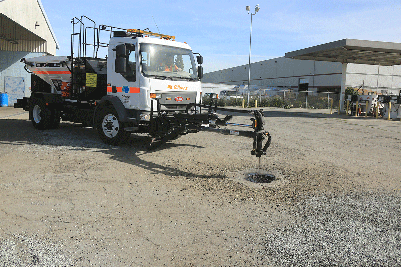Caltrans maintenance crews in the Bay Area are testing an automated pothole-filling truck from the safety of the truck cab. Photo by District 4 
District 4 Public Information Officer
Caltrans maintenance crews were pleased to find a few convenient potholes and convenient is not a word often associated with potholes. Potholes, almost by definition are inconvenient, cropping up on cold, rainy days, often on busy highways, when maintenance staff is stretched thin by multiple dispatch call-outs.
But the maintenance crews needed a few nearby potholes to test and practice using a new truck designed to automate the process of filling potholes. Luckily, the pavement in the maintenance yard is old and worn, conveniently riddled with potholes, creating an optimal place to test and practice using this new machine without venturing onto the traveled road.
At 26-feet long, the truck looks like a medium-sized vacuum truck or a small tanker truck. It has a hopper filled with small stones and a tank to hold hot emulsion. The hopper and tank connect to a large hose that rides on a boom at the front of the truck. From the cab, the operator can move the boom so that the hose's nozzle can hover directly over a choice pothole.
Since everything necessary to fill a pothole can be applied through the hose, no one needs to step out of the truck - a huge boost for safety. The entire pothole-filling process can be done with a simple push of buttons.
A group of District 4 Caltrans Maintenance workers practiced using the new machine. While sitting in the front seat of the cab, the operator moves the joystick, a control lever with a half-dozen multi-colored buttons on top. Each button is assigned to a pothole-filling processes: blower, emulsion, stones, etc. The operator must first blow the debris out of the hole. With a press of a button, a blast of air sends a flurry of debris, stones and dirt flying from the pothole. The operator then adds the emulsion into the pothole. With a press of another button, emulsion is automatically added.
Next, the operator must blanket the sides and bottom of the pothole with fluid. With a press of another button a jet of inky fluid automatically blankets the sides and bottom of the pothole. The operator then presses another button, and a jumble of emulsion-coated stones rattle out of the nozzle, sounding like coins tumbling from a slot machine. Finally, the operator presses the last button, which automatically sprays a top layer of clean pebbles as a finishing touch.
The District 4 Caltrans Maintenance workers acknowledged that it’s going to take some practice to learn this process. However, the hope is that it will only take minutes to fill a pothole, once they get the process down.
It will also cut down on the number of workers and vehicles needed to patch the pavement.
Hot asphalt is the preferred material for patching potholes, but applying it requires the most workers, equipment and at least one trip to the asphalt plant.
The alternative is cold patch, which as the name implies, is unheated asphalt. Cold patch can be stored in the maintenance yard, so using it requires less time and effort. But it doesn't stick as well, which can be a big problem on busy roads. Cold patch is often used as a stopgap measure until a better, more permanent repair can be made.
The automated pothole-filling truck applies a hot patch, a durable fix that doesn't require a trip to a plant, nor workers to shovel asphalt into a hole next to a lane buzzing with traffic traveling up to 70 mph.
It's a sunny day in the maintenance yard, but Equipment Operator Glenn Michael has abundant memories of wet, cold days when he filled potholes as traffic whooshed by. He’s just learning to operate the truck’s controller, but he likes the idea of filling holes from the cab of a truck.
“This machine will make it much safer to get out there, fill the pothole and be on our way to the next trouble spot,” says Michael. “It promises to be much more efficient as well.”
Caltrans purchased one automated pothole-filling truck. After training is complete, it will venture onto the state highway. If all goes well, Caltrans may be able to get more workers off the road and into an automated pothole-filling truck.
Technology is paving the way.

